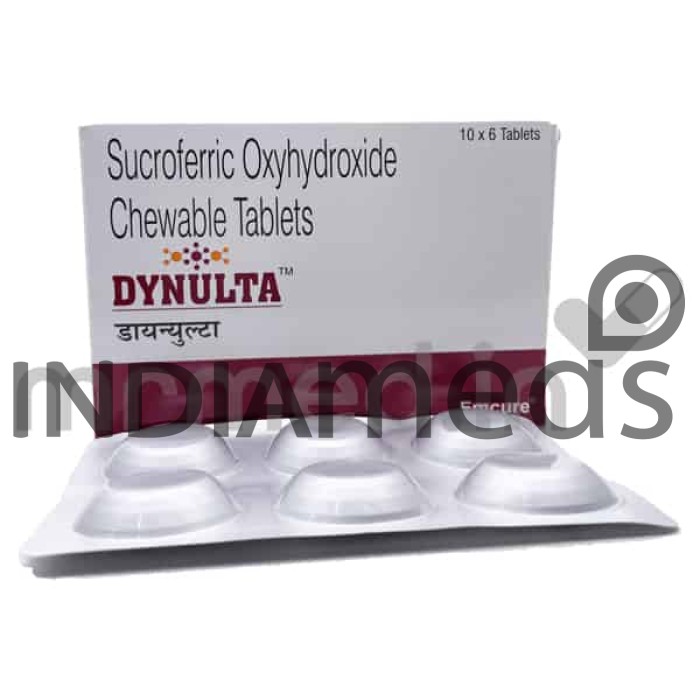Dynulta Tablet contains the active component sucroferric oxyhydroxide. It is classified as a phosphate binder. This medication treats hyperphosphatemia in patients with chronic kidney disease (CKD) who are on dialysis. Hyperphosphatemia is characterized by abnormally high levels of phosphate in the blood, a common complication of CKD. This medicine contains iron, which can benefit individuals with CKD who often experience iron deficiency anemia. Providing iron and phosphate binding helps address iron deficiency and support red blood cell production.
You should not take Dynulta Tablet if you are allergic to it or its components. Allergic reactions can range from mild to severe and may include symptoms such as rash, itching, swelling, dizziness, or difficulty breathing. Patients with iron overload disorders, such as hemochromatosis (iron overload disorder), or those receiving high-dose intravenous iron therapy should use Dynulta Tablet cautiously. The use of this medicine in pediatric patients has not been extensively studied, and its safety and effectiveness in this population have yet to be established.
Therapeutic Effects of Dynulta Tablet
Pregnancy
The safety of Dynulta Tablet during pregnancy has not been well established, and there is limited clinical data regarding its use in pregnant women. Therefore, caution is advised when considering the use of this medication during pregnancy.
Breast Feeding
The safety of Dynulta Tablet during breastfeeding has not been well studied, and there is limited information on its excretion into human breast milk. Therefore, caution is advised when considering the use of breastfeeding.
Lungs
Dynulta Tablet is not known to have specific safety concerns related to the lungs. If you have a pre-existing lung condition or are concerned about the safety of this medication in relation to your lungs, it is important to discuss your concerns with your healthcare provider.
Liver
The safety of Dynulta Tablet in individuals with liver disease has not been extensively studied. If you have liver disease or concerns about the safety of your liver, it is important to discuss these concerns with your healthcare provider.
Alcohol
Excessive alcohol consumption can negatively affect your health, especially if you have underlying liver disease or other medical conditions. Alcohol can also contribute to dehydration, which may affect the management of certain medical conditions.
Driving
Dynulta Tablets can cause side effects that may impair your ability to drive or operate machinery safely. Common side effects are drowsiness and dizziness. These effects can affect your coordination, reaction time, and judgment, making driving unsafe or performing tasks requiring alertness.
Serious:
- Allergic reaction
- Breathlessness
- Black stools
Common:
- Diarrhea
- Discolored feces (usually dark or black)
- Constipation
- Nausea
- Vomiting
- Stomach pain or discomfort
- Indigestion or heartburn
Dynulta tablets may interfere with certain laboratory tests that measure iron or phosphate levels. It is important to inform healthcare professionals performing these tests that you are taking this medication, as they may need to consider potential interference or make adjustments to the testing methodology.
Dynulta Tablet is primarily used in patients with chronic kidney disease who are on dialysis. However, in patients with severe kidney dysfunction who are not on dialysis, the use of this medication may need to be carefully evaluated by a healthcare provider due to the potential accumulation of the medication and associated risks.
The use of Dynulta Tablet in patients with a history of gastrointestinal bleeding or ulcers should be cautiously approached. It is important to discuss your medical history with your healthcare provider, who can evaluate the potential risks and benefits of using this medication in your specific case.
Dynulta Tablets can be used in elderly patients; however, caution should be exercised due to the increased likelihood of age-related conditions and potential interactions with other medications commonly taken by older individuals. Your healthcare provider will consider your overall health and individual circumstances to determine the appropriate use of this medication in elderly patients.
Dynulta Tablet is often used as a long-term treatment for chronic kidney disease in patients on dialysis. Your healthcare provider will determine the duration of treatment based on your individual needs and response to therapy. Regular follow-up visits will allow your healthcare provider to assess the ongoing efficacy and safety of this medication for your condition.
If you experience any side effects while taking Dynulta Tablet, it is important to report them to your healthcare provider promptly. They can evaluate the symptoms and determine the appropriate course of action.
Molecule name: Sucroferric oxyhydroxide | Therapeutic class: Phosphate lowering agent |
Pharmacological class: Phosphate binders | Indications: High Phosphate Levels in Blood |








